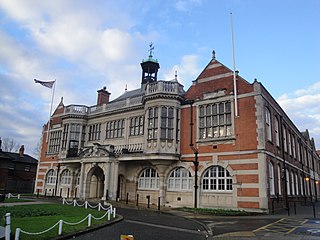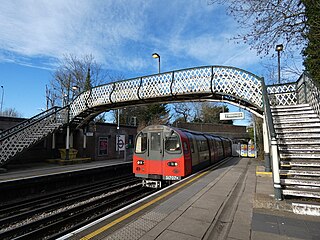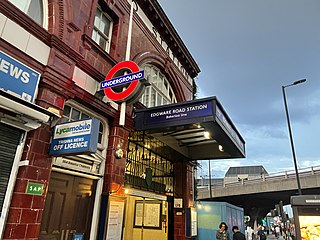
Hendon is an urban area in the Borough of Barnet, northwest London 7 miles (11 km) northwest of Charing Cross. Hendon was an ancient manor and parish in the county of Middlesex and a former borough, the Municipal Borough of Hendon; it has been part of Greater London since 1965. Hendon falls almost entirely within the NW4 postcode, while the West Hendon part falls in NW9. Colindale to the northwest was once considered part of Hendon but is today separated by the M1 motorway.

The London Borough of Barnet is a local authority area on the northern outskirts of London. The borough was formed in 1965 from parts of the ceremonial counties of Middlesex and Hertfordshire. It is the second largest London borough by population with 389,344 inhabitants as of 2021, also making it the 17th largest district in England. The borough covers an area of 86.74 square kilometres (33 sq mi), the fourth highest of the 32 London boroughs, and has a population density of 45.8 people per hectare, which ranks it 25th.

Camden Town is a London Underground station in Camden Town. It is a major junction for the Northern line, as it is where the Edgware and High Barnet branches merge from the north, and is also where they split to the south into the Bank and Charing Cross branches for the journey through Central London. It is particularly busy with visitors to the Camden markets at weekends, and, until 2019, was exit-only on Sundays to prevent overcrowding.

East Finchley is a London Underground station in East Finchley in the London Borough of Barnet, north London. The station is on the High Barnet branch of the Northern line, between Finchley Central and Highgate stations, and is in Travelcard Zone 3.

Highgate is a London Underground station and former railway station in Archway Road, in the London Borough of Haringey in north London. The station takes its name from nearby Highgate Village. It is on the High Barnet branch of the Northern line, between East Finchley and Archway stations, and is in Travelcard Zone 3.

High Barnet is a London Underground station, and former railway station, located in Chipping Barnet, North London. The station is the northern terminus of the High Barnet branch of the Northern line and is in Travelcard Zone 5. It is situated 10.2 miles (16.4 km) north north-west of Charing Cross. The next station towards south is Totteridge & Whetstone.

Edgware is a London Underground station in Edgware, in the London Borough of Barnet, in North London. The station is the northern terminus of the Edgware branch of the Northern line and the next station towards south is Burnt Oak. Edgware is in Travelcard Zone 5.

Mill Hill East is a London Underground station in Mill Hill in the London Borough of Barnet, north London. The station is the terminus and only station of a single-track branch of the Northern line from Finchley Central station and is in Travelcard Zone 4. It is the least used station on the Northern line with 1.41 million passengers in 2022.

Hendon Central is a London Underground station in North West London on the A41. It is on the Edgware branch of the Northern line, between Colindale and Brent Cross stations, and is on the boundary between Travelcard Zone 3 and Zone 4. Its postcode is NW4 2TE. It was opened along with Brent Cross tube station on 19 November 1923 as the first stage of an extension of the Golders Green branch of the Charing Cross, Euston and Hampstead Railway. The station served as the terminus of the line's western fork until 18 August 1924 when the second and final section of the extension to Edgware was opened.

Burnt Oak is a London Underground station in Burnt Oak, north London, on Watling Avenue, off the A5. The station is on the Edgware branch of the Northern line, between Edgware and Colindale stations, and is in Travelcard Zone 4.

Brent Cross is a London Underground station located on Highfield Avenue in the Golders Green area of north west London. The station is a Grade II listed building.

Golders Green is a London Underground station in Golders Green, north London. The station is on the Edgware branch of the Northern line between Brent Cross and Hampstead stations. It is in Travelcard Zone 3 and is the first surface station on the Edgware branch when heading north.

Finchley Central is a London Underground station in the Church End area of Finchley, north London. The station is located on the High Barnet branch of the Northern line, between West Finchley and East Finchley stations; it is the junction for the short branch to Mill Hill East. The station is around 7 miles north-northwest of Charing Cross and is in Travelcard Zone 4.

Totteridge & Whetstone is a London Underground station in Whetstone in the London Borough of Barnet, North London. It is on the High Barnet branch of the Northern line, between High Barnet and Woodside Park stations, in Travelcard Zone 4. It was first built in 1872.

West Finchley is a London Underground station in the Finchley area of the London Borough of Barnet. The station is on the High Barnet branch of the Northern line between Woodside Park and Finchley Central stations and is in Travelcard Zone 4.

Woodside Park is a London Underground station in Woodside Park, north London.

Colindale is a district in the London Borough of Barnet; its main shopping street on the A5 forming the borough boundary with neighbouring Brent. Colindale is a suburban area, and in recent years has had many new apartments built. It is also the location of the 1960s–1970s Grahame Park housing estate, built on former parts of Hendon Aerodrome. It is situated about eight miles northwest of Charing Cross, directly northwest of Hendon, to the south of Edgware and east of Queensbury.

Grahame Park, located on the site of the old Hendon Aerodrome in North West London, is a north London housing estate in the London Borough of Barnet, including 1,777 council homes built in the 1970s.

Edgware Road is a London Underground station on the Bakerloo line, located in the City of Westminster. It is between Paddington and Marylebone stations on the line and falls within Travelcard zone 1. The station is located on the north-east corner of the junction of Edgware Road, Harrow Road and Marylebone Road. It is adjacent to the Marylebone flyover.

Paddington is a London Underground station served by the Bakerloo, Circle and District lines. It is located on Praed Street to the south of Paddington mainline station and has entrances from Praed Street and from within the mainline station. On the Bakerloo line the station is between Warwick Avenue and Edgware Road and on the Circle and District lines it is between Bayswater and Edgware Road. It is in London Fare Zone 1.


























